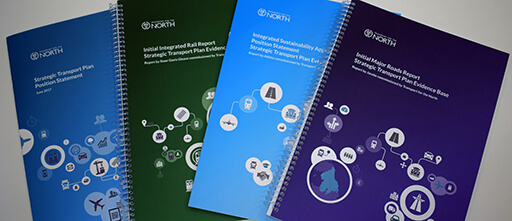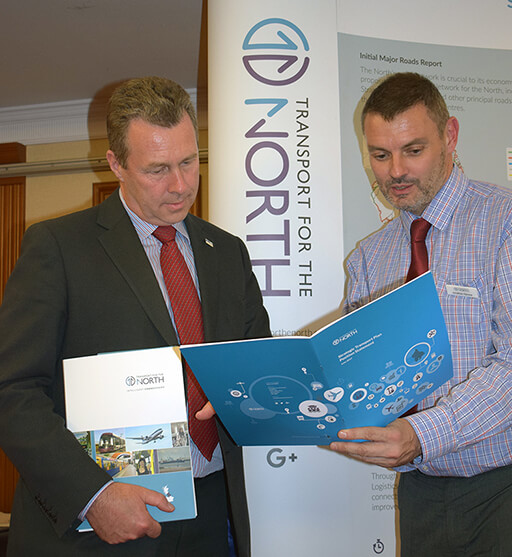Transport for the North (TfN) met with business and public sector delegates in Hull on Monday 17 July to showcase locally, for the first time, the evidence that will inform its Strategic Transport Plan.
The first of its kind, the Plan is being developed to transform the North’s economy through investment in the region’s transport infrastructure. It could help create close to a million new jobs and add almost £100 billion to the UK’s economy.

The evidence presented in Hull includes a Position Statement, Initial Major Roads Report and Initial Integrated Rail Report. The work has been developed in collaboration with stakeholders and Partners from all over the North. It will help shape the Strategic Transport Plan that TfN will adopt when it becomes the first Statutory Sub-National Transport Body in England.
David Brown, TfN’s Chief Executive Officer, said:
“TfN has a clear mission to transform the North’s economy by intelligently developing our transport infrastructure.
“The publication of this evidence is a pre-cursor to our multi-modal Strategic Transport Plan, which will be published for consultation later this year. The work presents a compelling case for change, underlining the economic and strategic benefits of improving freight and passenger transport across the whole of the North to drive economic growth.
“We want to enable the North to make a more significant contribution to the UK economy, through higher productivity, while also increasing job opportunities. This will require the delivery of a sustained and aspirational investment programme across the North to build infrastructure, strengthen skills, harness innovation and encourage smart and innovative technology.
The session in Hull on Monday was one of 42 Transport for the North engagements across the North, to present and discuss the evidence base that explains the rationale behind the developing Strategic Transport Plan, which will help shape the North for decades to come. The events are aimed at giving businesses and public sector representatives throughout the region a real understanding of what the plan is about, what it means for the North and to hear their views on it.

External Affairs Manager for the Hull & Humber Chamber of Commerce, David Hooper, said:
“This event has been a useful opportunity to directly raise with Transport for the North the issues which concern our Humber businesses and to support their long-term strategic look at what’s required for the future.
“It’s good to know that Hull and the Humber have been identified by TfN as a key centre of economic interest with significant potential for growth through investment in vital transport infrastructure links.
“The Chamber recently highlighted its concerns over the proposed downgrading of train services to Leeds and Manchester, the lack of a direct train to London from Grimsby to support its rapidly growing renewables industry and the importance of electrification from Selby to Hull to ensure long-term connectivity across the Northern Powerhouse area.
“Concerns over the M62 and the increasingly pressing requirement to upgrade the A15 to improve access to our South Bank ports and industries were also discussed.
“We highlighted the potential of HS3, or “The Hullapool Line” as we’ve dubbed it, to make relatively easy wins and connect the two great ports in the West and East of the country.
“The Chamber also raised its concerns over the Castle Street road scheme which is seen as crucial for Hull’s future prosperity and despite years in planning, has still to be given the go-ahead by the Highways Agency. The Chamber asked Transport for the North to exert any influence it can to ensure the scheme is approved promptly.
“The Chamber will look to work closely with Transport for the North going forward to ensure the projects which are crucial to the Humber’s future prosperity are raised higher up the organisational agenda”.
TfN’s Position Statement explains how the Plan will add value for people and businesses across the North and aligns it with economic and transport plans at both a regional and national level. The Plan will be used to inform the agendas of the Department for Transport, Highways England and Network Rail with regional intelligence.
Hull has been identified by Transport for the North as a key centre of economic interest with significant potential for growth through investment in vital transport infrastructure links – particularly between east and west and with Port infrastructure. The UK City of Culture lies firmly within one of the central ‘Strategic Development Corridors’ identified by Transport for the North as key for future development if the organisation’s vision for ‘transformational’ change in the North is to be realised.
Many businesses across the Humber, including logistics, freight, manufacturing, retail, leisure and tourism, are reliant on an efficient road system. The Initial Major Roads Report outlines the importance of strategic road connectivity in delivering transformational economic growth. It introduces the concept of a Major Road Network for the North which connects the important economic centres and provides a coherent and integrated system which is resilient, reliable and efficient.
Similarly, the Initial Integrated Rail Report identifies strategic improvements needed to rail services and infrastructure across the North to enable easier commuting, better business links and greater international connectivity. Building on this work, TfN will develop an integrated rail plan by the end of 2017 that will incorporate development work on the proposed Northern Powerhouse Rail network and research from TfN’s sister organisation Rail North.
Both reports establish priorities for connectivity and are used to identify nine strategic development corridors across the North, including Integrated and Smart Travel and Northern Powerhouse Rail.
All documents comprising the Strategic Transport Plan evidence base can be found on TfN’s website, www.transportforthenorth.com
ENDS
Notes to editors: